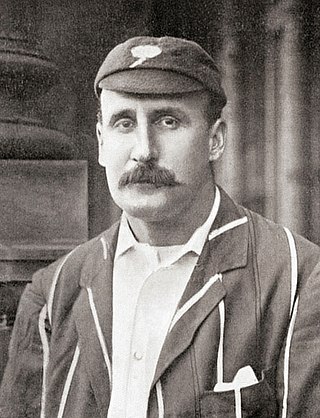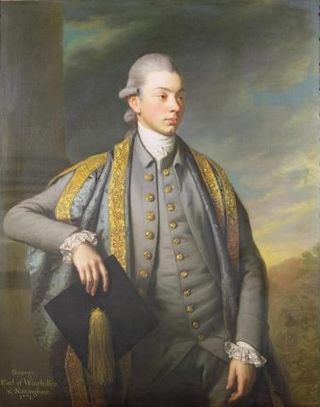Related Research Articles

Marylebone Cricket Club (MCC) is a cricket club founded in 1787 and based since 1814 at Lord's Cricket Ground, which it owns, in St John's Wood, London. The club was formerly the governing body of cricket retaining considerable global influence.

Lord's Cricket Ground, commonly known as Lord's, is a cricket venue in St John's Wood, London. Named after its founder, Thomas Lord, it is owned by Marylebone Cricket Club (MCC) and is the home of Middlesex County Cricket Club, the England and Wales Cricket Board (ECB), the European Cricket Council (ECC) and, until August 2005, the International Cricket Council (ICC). Lord's is widely referred to as the Home of Cricket and is home to the world's oldest sporting museum.

Kent County Cricket Club is one of the eighteen first-class county clubs within the domestic cricket structure of England and Wales. It represents the historic county of Kent. A club representing the county was first founded in 1842 but Kent teams have played top-class cricket since the early 18th century, and the club has always held first-class status. The current Kent County Cricket Club was formed on 6 December 1870 following the merger of two representative teams. Kent have competed in the County Championship since the official start of the competition in 1890 and have played in every top-level domestic cricket competition in England. The club's limited overs team is called the Kent Spitfires after the Supermarine Spitfire.

Martin Bladen Hawke, 7th Baron Hawke, generally known as Lord Hawke, was an English amateur cricketer active from 1881 to 1911 who played for Yorkshire and England. He was born in Willingham by Stow, near Gainsborough, Lincolnshire, and died in Edinburgh. He appeared in 633 first-class matches, including five Test matches, as a righthanded batsman, scoring 16,749 runs with a highest score of 166 and held 209 catches. He scored 13 centuries and 69 half-centuries.

Thomas Lord was an English professional cricketer who played first-class cricket from 1787 to 1802. He made a brief comeback, playing in one further match in 1815. Overall, Lord made 90 known appearances in first-class cricket. He was mostly associated with Middlesex and with Marylebone Cricket Club (MCC) as a ground staff bowler.

Gentlemen v Players was a long-running series of English first-class cricket matches. Two matches were played in 1806, but the fixture was not played again until 1819. It became an annual event, usually played at least twice each season, except for the years 1826, 1828, 1915–1918 and 1940–1945. In essence, it was a match between teams consisting of amateur ("Gentlemen") and professional cricketers ("Players") that reflected the English class structure of the 19th century: the Players were working class cricketers who earned their living through the game, whilst the Gentlemen were middle- and upper-class cricketers, usually products of the public school system, who were unpaid.
In English cricket, the years 1826–1845 were dominated by the roundarm bowling issue, which was resolved when the style was legalised in 1835, and by the formation of the first modern county clubs between 1839 and 1845.

George Finch, 9th Earl of Winchilsea, was an important figure in the history of cricket. His main contributions to the game were patronage and organisation but Winchilsea, an amateur, was also a very keen player. Finch served with the 87th Foot at the time of the American Revolutionary War from its formation in 1779 to its disbanding in 1783, with the temporary ranks of major and lieutenant-colonel. Finch was the first president of the Royal Institution, and it was through his influence that it received the endorsement of King George III.
County cricket teams representing Middlesex have been traced back to the 18th century, although for long periods the county was secondary to the London Cricket Club which played at the Artillery Ground. Middlesex teams played at various grounds throughout what is now the Greater London area. Islington and Uxbridge were often used but home matches were also played on Kennington Common and in Berkshire. Middlesex teams were less frequent in the 19th century until 1859 when the Walker family of Southgate became involved in county cricket.

The 1787 cricket season in England is noteworthy for the foundation of Marylebone Cricket Club (MCC) after the opening of Thomas Lord's first ground in the parish of Marylebone, north of London. MCC soon became the sport's governing body with the new ground as its feature venue. The first match known to have been played at Lord's was on Monday, 21 May, between the White Conduit Club and a Middlesex county team. The first match known to involve a team representing MCC was against White Conduit on Monday, 30 July. Including these two, reports and/or match scorecards have survived of numerous eleven-a-side matches played in 1787. Eleven are retrospectively, but unofficially, recognised as first-class.
1803 was the 17th season of cricket in England since the foundation of Marylebone Cricket Club (MCC). Thomas Howard made his debut in important matches.
1804 was the 18th season of cricket in England since the foundation of Marylebone Cricket Club (MCC). The first Eton v Harrow match may have been played at Lord's Old Ground.
1805 was the 19th season of cricket in England since the foundation of Marylebone Cricket Club (MCC). Lord Frederick Beauclerk became the first batsman known to have scored two centuries in the same season.
1806 was the 20th season of cricket in England since the foundation of Marylebone Cricket Club (MCC). The first two Gentlemen v Players matches took place, but the fixture was not played again until 1819.
1809 was the 23rd season of cricket in England since the foundation of Marylebone Cricket Club (MCC). Thomas Lord opened his Middle Ground after refusing to pay increased rent at the Old Ground.
In the 1810 English cricket season, William Ward made his top-class debut and The Bs were dismissed for a total of only 6.
Cricket, and hence English amateur cricket, probably began in England during the medieval period but the earliest known reference concerns the game being played c.1550 by children on a plot of land at the Royal Grammar School, Guildford, Surrey. It is generally believed that cricket was originally a children's game as it is not until the beginning of the 17th century that reports can be found of adult participation.

Lord's Middle Ground was a cricket venue in London that was established by Thomas Lord in 1811. It was used mainly by Marylebone Cricket Club for major matches until 1813, after which Lord was obliged to relocate because the land was requisitioned for the cutting of the Regent's Canal.
Amateur status had a special meaning in English cricket. The amateur in this context was not merely someone who played cricket in his spare time but a particular type of first-class cricketer who existed officially until 1962, when the distinction between amateurs and professionals was abolished and all first-class players became nominally professional.
Through the Napoleonic Wars, county cricket virtually died as cricket was impacted by losses of investment and manpower.
References
- ↑ Arthur Haygarth, Scores & Biographies, Volume 1 (1744–1826), Lillywhite, 1862
- ↑ CricketArchive – matches played on Lord's Middle Ground. Retrieved on 25 December 2010.